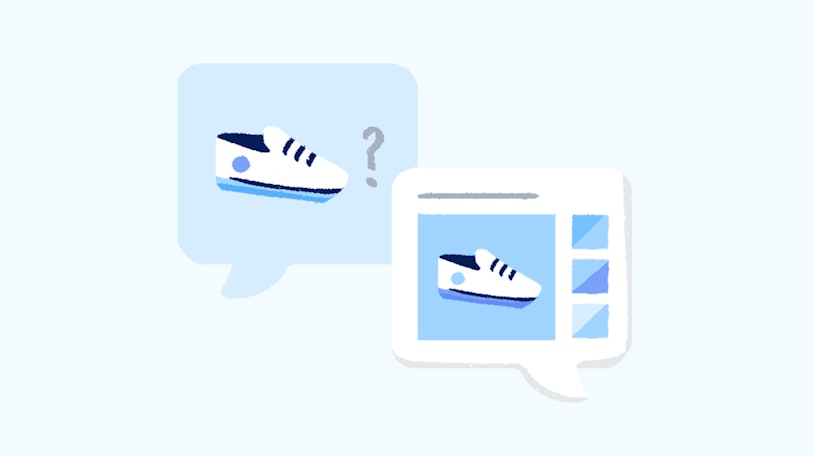One of the essential things that support leaders have to consider is which channels will be best for their customers. Email vs. live chat support is often a contentious conversation in that debate. Both channels are excellent for different reasons, and your customers may feel curious and excited about both.
Each channel has many pros and cons, and they both require different skills from the customer service team members that staff them. Read on for a breakdown of both popular channels and how they compare to each other.
This is a chapter in our Ultimate Guide to Live Chat Support. When you're ready, check out the other chapters:
Chapter 1 – Customer Service Live Chat: A Guide for 2025
Chapter 2 – Key Live Chat Statistics for Customer Service Teams
Chapter 3 – 101 Best Live Chat Response Examples for Customer Service
Chapter 4 – The Best Free Live Chat Software in 2025
Chapter 5 – The 12 Best Ecommerce Live Chat Tools
Chapter 6 – Actionable Live Chat Metrics to Start Tracking Today
Live chat support and email support comparison
While it’s true that both channels can be used for customer support, depending on your audience and type of product, one may serve you better than the other.
Benefits of email vs. live chat support
There are tons of benefits to both of these amazing channels, so let’s break them down side by side.
| Live Chat | |
|---|---|
Cost effective: Email is one of the most basic channels and is often the most cost effective. | Scale your customer efforts: Each representative can handle multiple customers at a time. |
Flexible: Email allows you to include things like images, font styling, infographics, and forms. | Optimize conversions: You can target customers and show a chat window right when they need help. |
Scalable: Whether you have five hundred customers or five million, email can accommodate them. | Direct interaction: Your customer support team members are speaking directly to your customers at the moment of need. |
Brand awareness: You can ensure that your email templates and content style match your brand’s site, product, and blog. | Quick responses: You can get immediate feedback from the customer about what is or isn’t working. |
Equal footing for all customers: Almost everyone knows how to write and receive an email. | Efficient handling: The resolutions on live chat are typically quicker than through other channels. |
No need for an immediate response: Customers don’t traditionally expect an immediate response from email, which means your team has a bit more leeway for discovery and troubleshooting. | Empathy: The type of conversation and dialogue that occurs over chat can help customers feel more deeply understood. |
Easier to verify identities: When someone sends an email, it’s much easier to verify that they are who they say they are. | Easy involvement for other teams: If there are other teams that also want to engage customers, like marketing or sales, they can easily do so with chat. |
Downsides of email vs. live chat support
No channel is 100% perfect. Just as there are strong benefits to email vs. live chat support, there are also weaknesses. Here are the top issues that customer service teams find with each channel.
| Live chat | |
|---|---|
Long queues: Because email support representatives aren’t required to answer immediately, sometimes it can take a longer time to get a response. | Availability: You need to have someone available on your team at all times to handle live chat. |
Delay in question clarification and follow up: Customers need to wait until their next email to follow up with any additional questions, and so does the support rep! | Agents must multitask and solve problems quickly: Handling multiple conversations at once in a more fast-paced channel requires team members to find resolutions much more quickly than through other channels. |
Lower empathy: It can be really hard to pick up on nuance quickly in an email. | Bots and scripted responses: These can be painful for customers — more so than in email because they are used with more frequency. |
Deliverability issues: Sometimes emails don’t get to the right person because of inbox rules or restrictions or if someone misenters an email address in the contact form. | Waiting feels more painful: Because chat is supposed to be immediate, when a customer has to wait for a rep to respond to a chat, it can feel even more painful than in other channels. |
Potential for mistaken spam reporting: If enough people report your company emails as spam, you may run into support issues. | Doesn’t work the same on all platforms: The chat experience may be different if a customer is on mobile or in the browser. |
Difficult to navigate: Long email threads can be very difficult to read and even more difficult to comprehend. | Time zone issues: If a customer is in a time zone where you don’t currently staff a live chat support rep, it could be painful for them to always be sent to another channel. |
Unclear expectations: Customers don’t always know when they can expect a response. | Less secure: Unlike some other channels, it can be hard to verify identity and security over chat. |
How to select the right channel for your company
Now that you have all of the information at your fingertips, it may feel even more overwhelming to pick which channel works best for your company. While the correct answer is probably best found in talking to your customers and hearing what they care about most, there are a few things to consider when thinking about which channel to use in which context.
When does email make sense?
Email is great when there are technical issues to convey or identity verification needs. Live chat isn’t well-suited for screenshots, sending along code, or sending URLs that can quickly get lost in the flow of conversation. Email also creates a paper trail and tracks what information the customer has or hasn't sent.
Email is also very cost-effective and serves the most significant amount of customers — most people have access to an email provider. In contrast, you can't guarantee that chat applications will work on every device and operating system. If you are just getting started in your support journey, email support is a great place to begin to serve the most significant amount of people at the lowest cost.
When does live chat make sense?
Live chat is great if you are working on a reasonably nontechnical product or are looking to leverage more conversions in a product-led growth model. Similarly, if you have a product targeted toward younger or more mobile-driven demographics, you may find that they want to use live chat more.
Use live chat for things like helping customers in context with issues that they have on your account or billing pages or to direct quick responses to easily-answered inquiries. For instance, if you have a filter built into your contact page that serves documentation for ticket deflection, consider also offering live chat as one of the options.
If you do use live chat, make sure you have enough coverage. There is nothing worse than a customer getting used to being able to reach out through live chat and then suddenly not having it available anymore. Set expectations for your customers, especially if you are beta-testing live chat or are only offering it within specific windows of your business day.
Which channel should you start with?
There are two things to consider when choosing your first support channel: what you can handle and what your customers want. If you have a small team and a limited budget, chances are that email is the only realistic option, since chat tends to be quite resource-heavy.
If you don't have budgetary or staffing concerns, then talking with your customers to find their preferred communication channel can be productive. Evaluate what they are asking for, the customer satisfaction with the channels you are currently offering, and which demographics they come from. For instance, if you have a demographic that uses older operating systems and devices, it may not be best to start with live chat, which isn't always supported in older environments.
Once you know what your customers are most interested in and most equipped to use easily, it's time to narrow down your options based on what kind of support you offer. If your questions are usually technical, code-based, or require quite a bit of dense explanation and links to external content, starting with email may be the best bet. Conversely, if your conversations are all relatively quick and straightforward, you may be fine starting with live chat.
How to roll out live chat
If you decide that it's time to roll out live chat, you must do so with intentionality. Once you introduce something to your customers, you won't have the chance to undo any poor experiences that they may have in the process.
Get it right the first time, and you will have fewer messes to clean up in the long run. Here are a few best practices.
1. Plan your implementation
Before launching into a new project, the best thing you can do is conceptualize it. Consider things like:
Where do you want live chat to show?
Which of your team members will be working on live chat, if not all of them?
What hours do you want to provide live chat?
What will the alternative route of providing support be when you cannot offer live chat?
Will only your support team use live chat, or will marketing and sales also be using it?
What is your budget for live chat?
How will live chat integrate with the other channels that you currently offer?
What metrics will you use to measure success for your live chat offering?
Answering these questions will help your team grasp how you want to implement your live chat offering and what is important to you. Move forward with that information to craft a plan to implement this new channel and decide which steps to take next.
2. Customize your chat windows to match your brand
Many live chat providers offer the option to customize the text and styling of the chat box. Ensure that your chat windows and any extraneous bits that your chat functionality shows to customers match the branding of your product or your marketing site, depending on where you are going to show the windows.
While it may seem like a small detail, making sure that the chat matches the rest of your brand makes it appear much more professional and put together. Be sure to remove the chat provider's branding if that is something that they automatically apply to the windows, too.
3. Move slowly and test along the way
As with anything new, take your time to ensure that you are moving slowly and methodically through your implementation plan. Test anything new that you implement before rolling it out live.
For instance, if you are testing turning live chat off for specific time zones, try turning it off for a small window first to ensure that the functionality works as expected.
Check your assumptions about what a particular feature or change will do, and put measures in place to test them. Never assume that something will work the way you expect it to — test out saved replies, new features, styles, and macros before you turn them on live with your customers.
4. Train your team
Anytime you roll out a new channel, it's essential to train your team. Select team members who you think will naturally lend themselves to live chat as a channel, then work to ensure they know how to maximize the tool you have selected for live chat. Go through all of the saved replies that they may need to know how to use, and ensure that they are up to snuff on any differences in communication standards between live chat and the channels you were using previously.
As you roll out live chat, continue to do ongoing training and quality assurance to ensure that your standards for live chat stand as firm as they do for your other channels.
5. Set expectations
It is unlikely that you will be able to leave your live chat functionality on 24/7 right from the get-go. Be sure to let your customers know what they can expect as you move forward with your rollout.
For instance, if you can only offer live chat during your office hours of 9 a.m. to 5 p.m. EST, be sure to note that right as the live chat window opens up. You can set any expectations for communication cadence and frequency before the conversation starts by using settings within the live chat tool.
Many companies, for instance, choose to say something like, "We are not currently available for chat, but we have sent your inquiry to our email support team. They typically respond within 60 minutes during the business hours of 9 a.m. to 5 p.m. EST."
6. Track overtime
As you go into your live chat implementation, you should have some crucial success metrics in mind. Along with metrics specifically tied to live chat, like response time, try to keep track of metrics that existed before your implementation. For instance, note if customer satisfaction or customer effort score goes up.
Tracking overtime allows you to check your assumptions and measure if the things you were trying to improve by implementing a new channel are experiencing any movement.
7. Invite other teams
Consider implementing it for your sales or marketing teams once you've hit your stride with your support team using live chat. Don't roll out a new channel for every team that will use the product right from the start. Focusing on a rollout for one team and then expanding your usage as that team finds success allows you to have a much more controlled implementation.
A few different teams are likely chomping at the bit to use live chat, especially if your customer support team is finding success. Add individual teams to the product one by one to ensure that things don't get too cluttered too quickly.
Email vs. live chat support: Why not both?
There are significant benefits to both email and live chat support. While it may make sense to debate whether your team rolls out one or the other first, you will likely end up using both.
Both email and live chat have their benefits and can be helpful for different reasons. Evaluate what impact your team is trying to make on your support strategy, and review the pros and cons of each channel as you decide whether to implement it. Staffing both will require different competencies and strengths within your support team, so consider if you can support one over the other.
If you choose email over live chat or vice versa, just remember that it doesn’t have to be a permanent decision one way or the other. As your business and support needs scale and change, you can implement the other channel to meet your customers’ needs.








